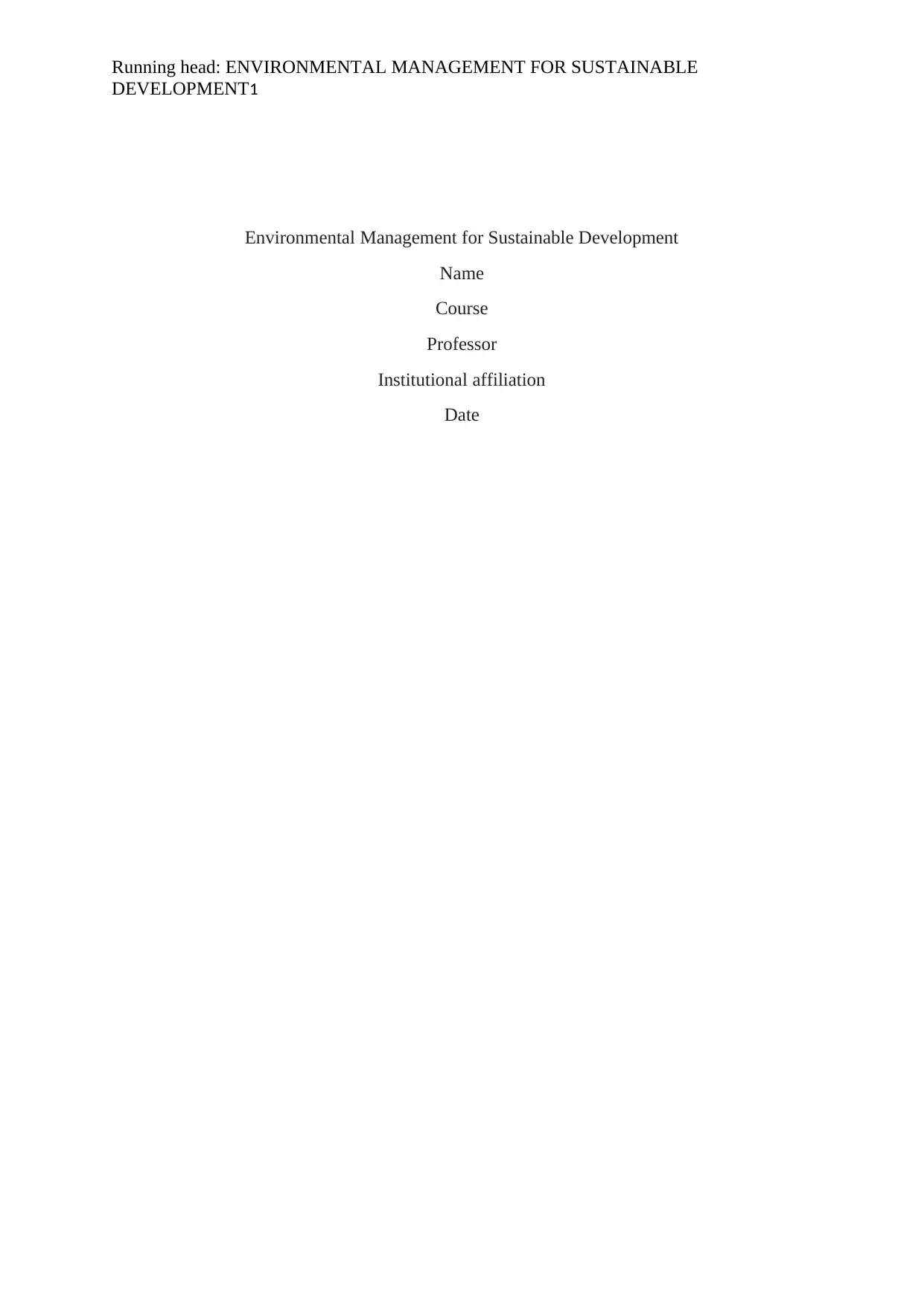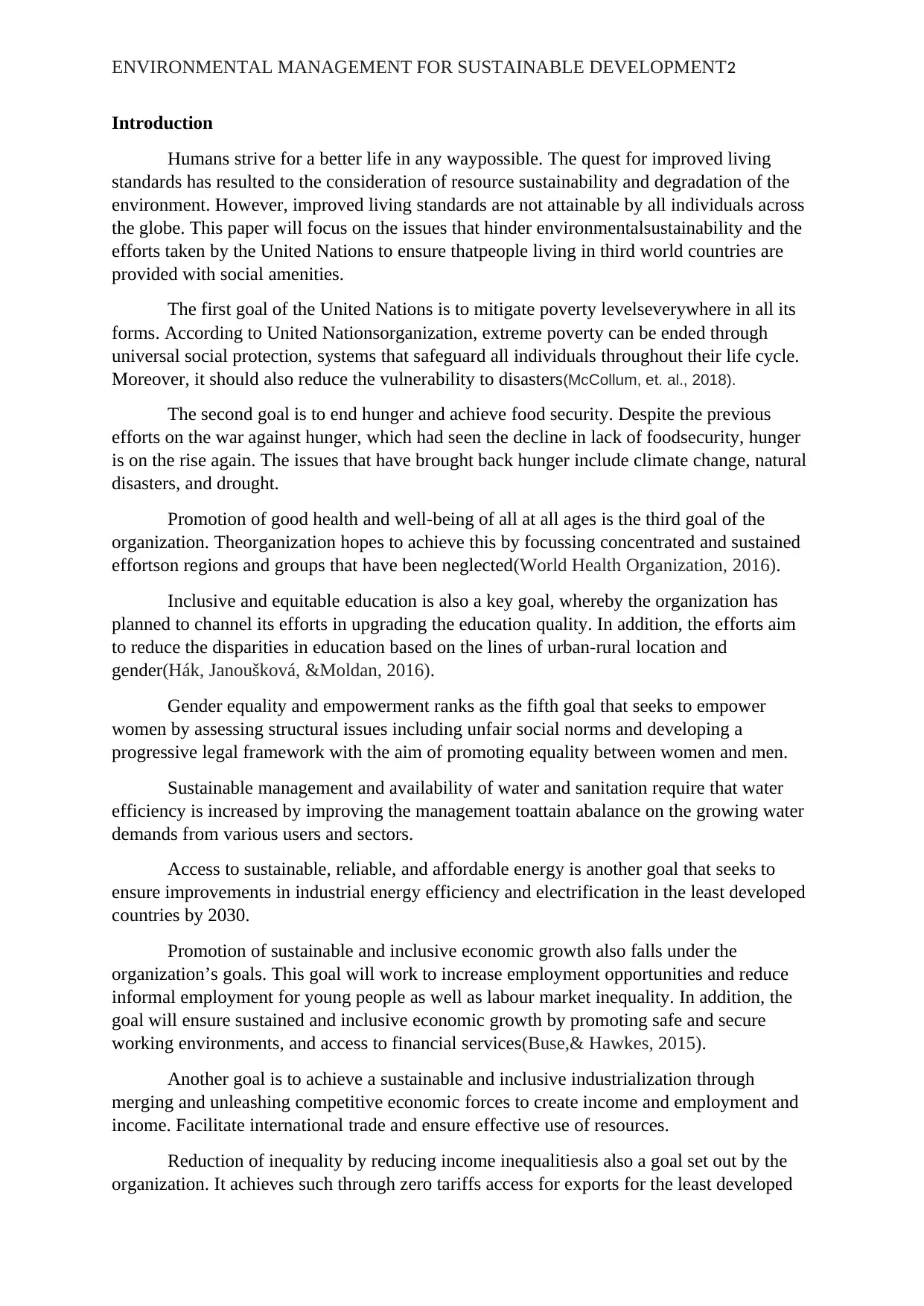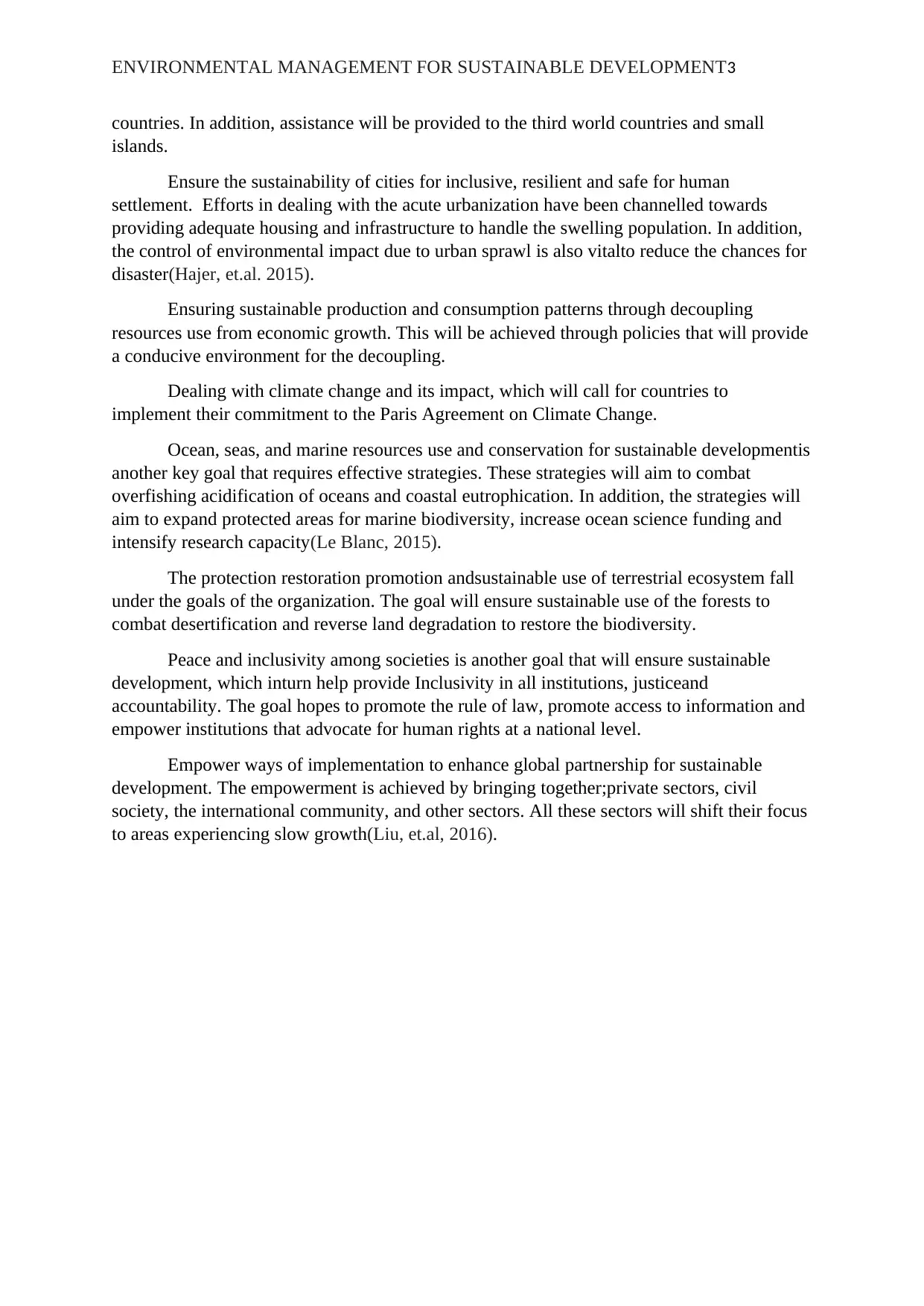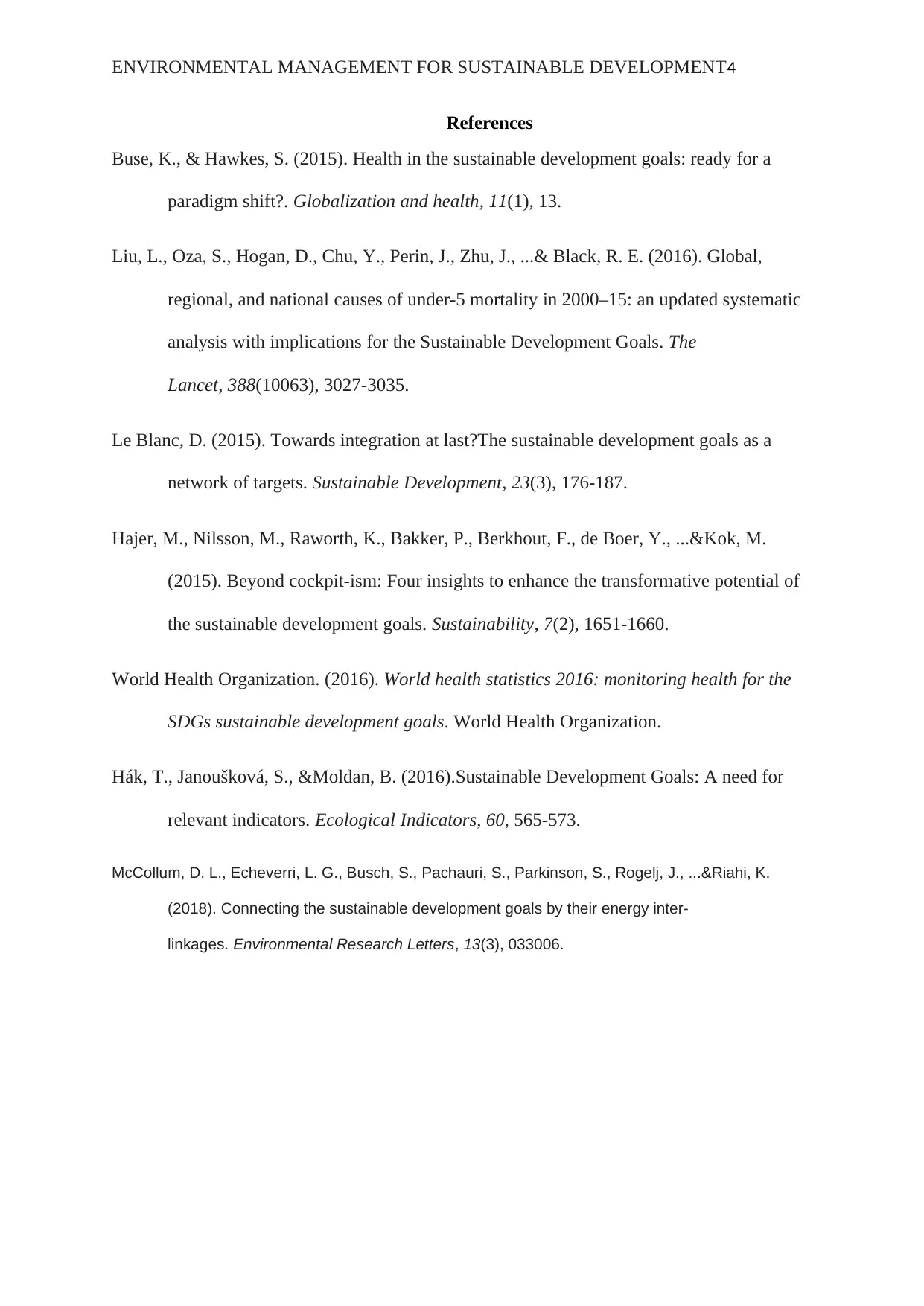Environmental Management for Sustainable Development - Detailed Report
VerifiedAdded on 2021/09/13
|4
|1221
|42
Report
AI Summary
This report provides an overview of environmental management for sustainable development, focusing on the challenges and the efforts of the United Nations. It explores how human activities impact resource sustainability and environmental degradation, particularly in the context of improving living standards globally. The report highlights the UN's key goals, including poverty reduction, food security, health and well-being, education, gender equality, water and sanitation, energy, economic growth, industrialization, inequality reduction, sustainable cities, sustainable production and consumption, climate change mitigation, ocean conservation, and terrestrial ecosystem protection. It also addresses the importance of peace, inclusivity, and global partnerships in achieving sustainable development. The report references several sources to support its analysis.

Running head: ENVIRONMENTAL MANAGEMENT FOR SUSTAINABLE
DEVELOPMENT1
Environmental Management for Sustainable Development
Name
Course
Professor
Institutional affiliation
Date
DEVELOPMENT1
Environmental Management for Sustainable Development
Name
Course
Professor
Institutional affiliation
Date
Paraphrase This Document
Need a fresh take? Get an instant paraphrase of this document with our AI Paraphraser

ENVIRONMENTAL MANAGEMENT FOR SUSTAINABLE DEVELOPMENT2
Introduction
Humans strive for a better life in any waypossible. The quest for improved living
standards has resulted to the consideration of resource sustainability and degradation of the
environment. However, improved living standards are not attainable by all individuals across
the globe. This paper will focus on the issues that hinder environmentalsustainability and the
efforts taken by the United Nations to ensure thatpeople living in third world countries are
provided with social amenities.
The first goal of the United Nations is to mitigate poverty levelseverywhere in all its
forms. According to United Nationsorganization, extreme poverty can be ended through
universal social protection, systems that safeguard all individuals throughout their life cycle.
Moreover, it should also reduce the vulnerability to disasters(McCollum, et. al., 2018).
The second goal is to end hunger and achieve food security. Despite the previous
efforts on the war against hunger, which had seen the decline in lack of foodsecurity, hunger
is on the rise again. The issues that have brought back hunger include climate change, natural
disasters, and drought.
Promotion of good health and well-being of all at all ages is the third goal of the
organization. Theorganization hopes to achieve this by focussing concentrated and sustained
effortson regions and groups that have been neglected(World Health Organization, 2016).
Inclusive and equitable education is also a key goal, whereby the organization has
planned to channel its efforts in upgrading the education quality. In addition, the efforts aim
to reduce the disparities in education based on the lines of urban-rural location and
gender(Hák, Janoušková, &Moldan, 2016).
Gender equality and empowerment ranks as the fifth goal that seeks to empower
women by assessing structural issues including unfair social norms and developing a
progressive legal framework with the aim of promoting equality between women and men.
Sustainable management and availability of water and sanitation require that water
efficiency is increased by improving the management toattain abalance on the growing water
demands from various users and sectors.
Access to sustainable, reliable, and affordable energy is another goal that seeks to
ensure improvements in industrial energy efficiency and electrification in the least developed
countries by 2030.
Promotion of sustainable and inclusive economic growth also falls under the
organization’s goals. This goal will work to increase employment opportunities and reduce
informal employment for young people as well as labour market inequality. In addition, the
goal will ensure sustained and inclusive economic growth by promoting safe and secure
working environments, and access to financial services(Buse,& Hawkes, 2015).
Another goal is to achieve a sustainable and inclusive industrialization through
merging and unleashing competitive economic forces to create income and employment and
income. Facilitate international trade and ensure effective use of resources.
Reduction of inequality by reducing income inequalitiesis also a goal set out by the
organization. It achieves such through zero tariffs access for exports for the least developed
Introduction
Humans strive for a better life in any waypossible. The quest for improved living
standards has resulted to the consideration of resource sustainability and degradation of the
environment. However, improved living standards are not attainable by all individuals across
the globe. This paper will focus on the issues that hinder environmentalsustainability and the
efforts taken by the United Nations to ensure thatpeople living in third world countries are
provided with social amenities.
The first goal of the United Nations is to mitigate poverty levelseverywhere in all its
forms. According to United Nationsorganization, extreme poverty can be ended through
universal social protection, systems that safeguard all individuals throughout their life cycle.
Moreover, it should also reduce the vulnerability to disasters(McCollum, et. al., 2018).
The second goal is to end hunger and achieve food security. Despite the previous
efforts on the war against hunger, which had seen the decline in lack of foodsecurity, hunger
is on the rise again. The issues that have brought back hunger include climate change, natural
disasters, and drought.
Promotion of good health and well-being of all at all ages is the third goal of the
organization. Theorganization hopes to achieve this by focussing concentrated and sustained
effortson regions and groups that have been neglected(World Health Organization, 2016).
Inclusive and equitable education is also a key goal, whereby the organization has
planned to channel its efforts in upgrading the education quality. In addition, the efforts aim
to reduce the disparities in education based on the lines of urban-rural location and
gender(Hák, Janoušková, &Moldan, 2016).
Gender equality and empowerment ranks as the fifth goal that seeks to empower
women by assessing structural issues including unfair social norms and developing a
progressive legal framework with the aim of promoting equality between women and men.
Sustainable management and availability of water and sanitation require that water
efficiency is increased by improving the management toattain abalance on the growing water
demands from various users and sectors.
Access to sustainable, reliable, and affordable energy is another goal that seeks to
ensure improvements in industrial energy efficiency and electrification in the least developed
countries by 2030.
Promotion of sustainable and inclusive economic growth also falls under the
organization’s goals. This goal will work to increase employment opportunities and reduce
informal employment for young people as well as labour market inequality. In addition, the
goal will ensure sustained and inclusive economic growth by promoting safe and secure
working environments, and access to financial services(Buse,& Hawkes, 2015).
Another goal is to achieve a sustainable and inclusive industrialization through
merging and unleashing competitive economic forces to create income and employment and
income. Facilitate international trade and ensure effective use of resources.
Reduction of inequality by reducing income inequalitiesis also a goal set out by the
organization. It achieves such through zero tariffs access for exports for the least developed

ENVIRONMENTAL MANAGEMENT FOR SUSTAINABLE DEVELOPMENT3
countries. In addition, assistance will be provided to the third world countries and small
islands.
Ensure the sustainability of cities for inclusive, resilient and safe for human
settlement. Efforts in dealing with the acute urbanization have been channelled towards
providing adequate housing and infrastructure to handle the swelling population. In addition,
the control of environmental impact due to urban sprawl is also vitalto reduce the chances for
disaster(Hajer, et.al. 2015).
Ensuring sustainable production and consumption patterns through decoupling
resources use from economic growth. This will be achieved through policies that will provide
a conducive environment for the decoupling.
Dealing with climate change and its impact, which will call for countries to
implement their commitment to the Paris Agreement on Climate Change.
Ocean, seas, and marine resources use and conservation for sustainable developmentis
another key goal that requires effective strategies. These strategies will aim to combat
overfishing acidification of oceans and coastal eutrophication. In addition, the strategies will
aim to expand protected areas for marine biodiversity, increase ocean science funding and
intensify research capacity(Le Blanc, 2015).
The protection restoration promotion andsustainable use of terrestrial ecosystem fall
under the goals of the organization. The goal will ensure sustainable use of the forests to
combat desertification and reverse land degradation to restore the biodiversity.
Peace and inclusivity among societies is another goal that will ensure sustainable
development, which inturn help provide Inclusivity in all institutions, justiceand
accountability. The goal hopes to promote the rule of law, promote access to information and
empower institutions that advocate for human rights at a national level.
Empower ways of implementation to enhance global partnership for sustainable
development. The empowerment is achieved by bringing together;private sectors, civil
society, the international community, and other sectors. All these sectors will shift their focus
to areas experiencing slow growth(Liu, et.al, 2016).
countries. In addition, assistance will be provided to the third world countries and small
islands.
Ensure the sustainability of cities for inclusive, resilient and safe for human
settlement. Efforts in dealing with the acute urbanization have been channelled towards
providing adequate housing and infrastructure to handle the swelling population. In addition,
the control of environmental impact due to urban sprawl is also vitalto reduce the chances for
disaster(Hajer, et.al. 2015).
Ensuring sustainable production and consumption patterns through decoupling
resources use from economic growth. This will be achieved through policies that will provide
a conducive environment for the decoupling.
Dealing with climate change and its impact, which will call for countries to
implement their commitment to the Paris Agreement on Climate Change.
Ocean, seas, and marine resources use and conservation for sustainable developmentis
another key goal that requires effective strategies. These strategies will aim to combat
overfishing acidification of oceans and coastal eutrophication. In addition, the strategies will
aim to expand protected areas for marine biodiversity, increase ocean science funding and
intensify research capacity(Le Blanc, 2015).
The protection restoration promotion andsustainable use of terrestrial ecosystem fall
under the goals of the organization. The goal will ensure sustainable use of the forests to
combat desertification and reverse land degradation to restore the biodiversity.
Peace and inclusivity among societies is another goal that will ensure sustainable
development, which inturn help provide Inclusivity in all institutions, justiceand
accountability. The goal hopes to promote the rule of law, promote access to information and
empower institutions that advocate for human rights at a national level.
Empower ways of implementation to enhance global partnership for sustainable
development. The empowerment is achieved by bringing together;private sectors, civil
society, the international community, and other sectors. All these sectors will shift their focus
to areas experiencing slow growth(Liu, et.al, 2016).
⊘ This is a preview!⊘
Do you want full access?
Subscribe today to unlock all pages.

Trusted by 1+ million students worldwide

ENVIRONMENTAL MANAGEMENT FOR SUSTAINABLE DEVELOPMENT4
References
Buse, K., & Hawkes, S. (2015). Health in the sustainable development goals: ready for a
paradigm shift?. Globalization and health, 11(1), 13.
Liu, L., Oza, S., Hogan, D., Chu, Y., Perin, J., Zhu, J., ...& Black, R. E. (2016). Global,
regional, and national causes of under-5 mortality in 2000–15: an updated systematic
analysis with implications for the Sustainable Development Goals. The
Lancet, 388(10063), 3027-3035.
Le Blanc, D. (2015). Towards integration at last?The sustainable development goals as a
network of targets. Sustainable Development, 23(3), 176-187.
Hajer, M., Nilsson, M., Raworth, K., Bakker, P., Berkhout, F., de Boer, Y., ...&Kok, M.
(2015). Beyond cockpit-ism: Four insights to enhance the transformative potential of
the sustainable development goals. Sustainability, 7(2), 1651-1660.
World Health Organization. (2016). World health statistics 2016: monitoring health for the
SDGs sustainable development goals. World Health Organization.
Hák, T., Janoušková, S., &Moldan, B. (2016).Sustainable Development Goals: A need for
relevant indicators. Ecological Indicators, 60, 565-573.
McCollum, D. L., Echeverri, L. G., Busch, S., Pachauri, S., Parkinson, S., Rogelj, J., ...&Riahi, K.
(2018). Connecting the sustainable development goals by their energy inter-
linkages. Environmental Research Letters, 13(3), 033006.
References
Buse, K., & Hawkes, S. (2015). Health in the sustainable development goals: ready for a
paradigm shift?. Globalization and health, 11(1), 13.
Liu, L., Oza, S., Hogan, D., Chu, Y., Perin, J., Zhu, J., ...& Black, R. E. (2016). Global,
regional, and national causes of under-5 mortality in 2000–15: an updated systematic
analysis with implications for the Sustainable Development Goals. The
Lancet, 388(10063), 3027-3035.
Le Blanc, D. (2015). Towards integration at last?The sustainable development goals as a
network of targets. Sustainable Development, 23(3), 176-187.
Hajer, M., Nilsson, M., Raworth, K., Bakker, P., Berkhout, F., de Boer, Y., ...&Kok, M.
(2015). Beyond cockpit-ism: Four insights to enhance the transformative potential of
the sustainable development goals. Sustainability, 7(2), 1651-1660.
World Health Organization. (2016). World health statistics 2016: monitoring health for the
SDGs sustainable development goals. World Health Organization.
Hák, T., Janoušková, S., &Moldan, B. (2016).Sustainable Development Goals: A need for
relevant indicators. Ecological Indicators, 60, 565-573.
McCollum, D. L., Echeverri, L. G., Busch, S., Pachauri, S., Parkinson, S., Rogelj, J., ...&Riahi, K.
(2018). Connecting the sustainable development goals by their energy inter-
linkages. Environmental Research Letters, 13(3), 033006.
1 out of 4
Related Documents
Your All-in-One AI-Powered Toolkit for Academic Success.
+13062052269
info@desklib.com
Available 24*7 on WhatsApp / Email
![[object Object]](/_next/static/media/star-bottom.7253800d.svg)
Unlock your academic potential
Copyright © 2020–2025 A2Z Services. All Rights Reserved. Developed and managed by ZUCOL.




